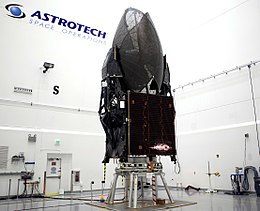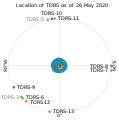 TDRS-L at the Astrotech payload processing facility TDRS-L at the Astrotech payload processing facility | |
| Mission type | Communications |
|---|---|
| Operator | NASA |
| COSPAR ID | 2014-004A |
| SATCAT no. | 39504 |
| Mission duration | Planned: 15 years Elapsed: 10 years, 11 months, 8 days |
| Spacecraft properties | |
| Bus | BSS-601HP |
| Manufacturer | Boeing |
| Launch mass | 3,454 kg (7,615 lb) |
| Start of mission | |
| Launch date | 24 January 2014, 02:33 (2014-01-24UTC02:33) UTC |
| Rocket | Atlas V 401 |
| Launch site | Cape Canaveral SLC-41 |
| Contractor | United Launch Alliance |
| Orbital parameters | |
| Reference system | Geocentric |
| Regime | Geosynchronous orbit |
| Perigee altitude | 35,785 kilometers (22,236 mi) |
| Apogee altitude | 35,797 kilometers (22,243 mi) |
| Inclination | 6.77 degrees |
| Period | 1436.03 minutes |
| Epoch | 22 January 2015, 07:10:47 UTC |

| |
TDRS-12, known before launch as TDRS-L, is an American communications satellite operated by NASA as part of the Tracking and Data Relay Satellite System. The twelfth Tracking and Data Relay Satellite, it is the second third-generation spacecraft to be launched, following TDRS-11 in 2013.
Spacecraft
TDRS-12 was constructed by Boeing, based on the BSS-601HP satellite bus. Fully fueled, it has a mass of 3,454 kg (7,615 lb), with a design life of 15 years. It carries two steerable antennas capable of providing S, Ku and Ka band communications for other spacecraft, with an additional array of S-band transponders for lower-rate communications with five further satellites. The satellite is powered by two solar arrays, which produce 2.8 to 3.2 kilowatts of power, while an R-4D-11-300 engine is present to provide propulsion.
Launch
The United Launch Alliance was contracted to launch TDRS-12. The spacecraft was launched on 24 January 2014 at 02:33 UTC (21:33 local time on 23 January). An Atlas V rocket was used, flying in the 401 configuration, with tail number AV-043. After launch, TDRS-12 was deployed into a high-perigee geosynchronous transfer orbit. The spacecraft raised itself into a geosynchronous orbit using its onboard propulsion system.
Gallery
See also
References
- ^ Krebs, Gunter. "TDRS K, L, M". Gunter's Space Page. Retrieved 23 January 2013.
- ^ "TRDS-L Lifts Off". NASA. 23 January 2014. Retrieved 24 January 2014.
- ^ "TDRS-12 Satellite details 2014-004A NORAD 39504". N2YO. 22 January 2015. Retrieved 25 January 2015.
- ^ "TDRS-K Media Kit" (PDF). NASA. Retrieved 23 January 2014.
- ^ Graham, William (23 January 2014). "ULA set to open 2014 campaign with Atlas V launch of TDRS-L". NASASpaceflight.com. Retrieved 23 January 2014.
- "TDRS-L Atlas V Mission Overview" (PDF). United Launch Alliance. Archived from the original (PDF) on 1 February 2014. Retrieved 23 January 2014.
| Tracking and Data Relay Satellite System | ||
|---|---|---|
| First generation |  | |
| Second generation | ||
| Third generation | ||
| ||
This article about one or more spacecraft of the United States is a stub. You can help Misplaced Pages by expanding it. |
This article about one or more communications satellites is a stub. You can help Misplaced Pages by expanding it. |





